Kami are the deities, divinities, spirits, mythological, spiritual, or natural phenomena that are venerated in the Shinto religion. They can be elements of the landscape, forces of nature, beings and the qualities that these beings express, and/or the spirits of venerated dead people. Many kami are considered the ancient ancestors of entire clans. Traditionally, great leaders like the Emperor could be or became kami.

The veneration of the dead, including one's ancestors, is based on love and respect for the deceased. In some cultures, it is related to beliefs that the dead have a continued existence, and may possess the ability to influence the fortune of the living. Some groups venerate their direct, familial ancestors. Certain religious groups, in particular the Eastern Orthodox Churches, Catholic Church and Anglican Church venerate saints as intercessors with God; the latter also believes in prayer for departed souls in Purgatory. Other religious groups, however, consider veneration of the dead to be idolatry and a sin.

Bihu is of three types and it is an important cultural festival unique to the Indian state of Assam – 'Rongali' or 'Bohag Bihu' observed in April, 'Kongali' or 'Kati Bihu' observed in October or November, and 'Bhogali' or 'Magh Bihu' observed in January. The festivals present an admixture of Tibeto-Barman, Austroasiatic and Indo-Aryan traditions entwined so intricately that it is impossible to separate them—festivals which are uniquely Assamese to which all communities of Assam had contributed elements. The Rongali Bihu is the most important of the three, celebrating spring festival. The Bhogali Bihu or the Magh Bihu is a harvest festival, with community feasts. The Kongali Bihu or the Kati Bihu is the sombre, thrifty one reflecting a season of short supplies and is an animistic festival.
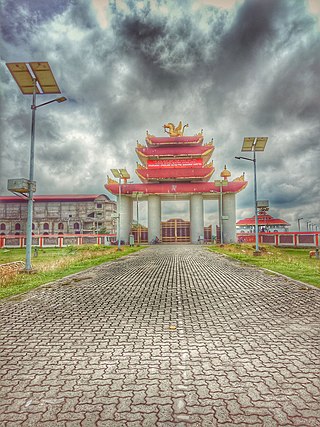
The Ahom or Tai-Ahom is an ethnic group from the Indian states of Assam and Arunachal Pradesh. The members of this group are admixed descendants of the Tai people who reached the Brahmaputra valley of Assam in 1228 and the local indigenous people who joined them over the course of history. Sukaphaa, the leader of the Tai group and his 9,000 followers established the Ahom kingdom, which controlled much of the Brahmaputra Valley in modern Assam until 1826.

The Ahom dynasty (1228–1826) ruled the Ahom Kingdom in present-day Assam, India for nearly 598 years. The dynasty was established by Sukaphaa, a Shan prince of Mong Mao who came to Assam after crossing the Patkai mountains. The rule of this dynasty ended with the Burmese invasion of Assam and the subsequent annexation by the British East India Company following the Treaty of Yandabo in 1826.
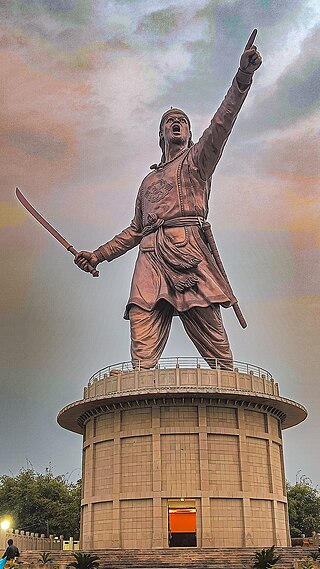
Lachit Borphukan son of Momai Tamuli Borbarua was an Ahom Borphukan, primarily known for commanding the Ahom Army and the victory in the Battle of Saraighat (1671) that thwarted an invasion by the vastly superior Mughal Forces under the command of Ramsingh I. He died about a year later in April 1672.

Susenghphaa or Pratap Singha, was the 17th and one of the most prominent kings of the Ahom kingdom. As he was advanced in years when he became king, he is also called the burha Raja. His reign saw an expansion of the Ahom kingdom to the west, the beginning of the Ahom-Mughal conflicts, and a reorganization of the kingdom with an expanded Paik system and reoriented village economy designed by Momai Tamuli Borbarua. His expansion to the west is underlined by the two new offices that he created: that of the Borbarua and the Borphukan. The alliances he formed with the rulers of Koch Hajo resulted in formation that successfully thwarted Mughal expansion. The administrative structure that he created survived until the end of the Ahom kingdom in 1826.

The Ahom kingdom was a late medieval kingdom in the Brahmaputra Valley that retained its independence for nearly 600 years despite encountering Mughal expansion in Northeast India. Established by Sukaphaa, a Tai prince from Mong Mao, it began as a mong in the upper reaches of the Brahmaputra based on wet rice agriculture. It expanded suddenly under Suhungmung in the 16th century and became multi-ethnic in character, casting a profound effect on the political and social life of the entire Brahmaputra valley. The kingdom became weaker with the rise of the Moamoria rebellion, and subsequently fell to repeated Burmese invasions of Assam. With the defeat of the Burmese after the First Anglo-Burmese War and the Treaty of Yandabo in 1826, control of the kingdom passed into East India Company hands.
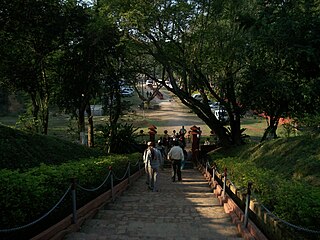
Charaideo or Che-Rai-Doi is a historic town situated in Charaideo district, Assam, India. Charaideo was established by the first Ahom king Chao Lung Siu-Ka-Pha in the year 1253 CE as the first capital of the Ahom kingdom. Even though the capital was shifted to different cities over the course of 600 years of Ahom rule, Charaideo remained the symbolic centre of Ahom power in Assam. It is now famous for its vast collection of maidams (tumuli) which are the burial mounds of the ruling Ahom kings and members of the Ahom royalty.
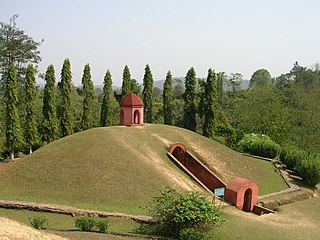
A maidam is a tumulus of the royalty and aristocracy of the medieval Ahom Kingdom (1228–1826) in Assam. The royal maidams are found exclusively at Charaideo; whereas other maidams are found scattered in the region between Jorhat and Dibrugarh towns. Structurally, a maidam consists of vaults with one or more chambers. The vaults have a domical superstructure that is covered by a hemispherical earthen mound that rises high above the ground with an open pavilion at the peak called chow chali. An octagonal dwarf wall encloses the entire maidam.
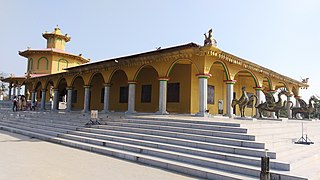
The Tai folk religion, Satsana Phi or Ban Phi is the ancient native ethnic religion of Tai people still practiced by various Tai groups. Tai folk religion was dominant among Tai people in Asia until the arrival of Buddhism and Hinduism. It is primarily based on worshipping deities called Phi, Khwan and Ancestors.

The Chutia Kingdom was a late medieval state that developed around Sadiya in present Assam and adjoining areas in Arunachal Pradesh. It extended over almost the entire region of present districts of Lakhimpur, Dhemaji, Tinsukia, and some parts of Dibrugarh in Assam, as well as the plains and foothills of Arunachal Pradesh. The kingdom fell around the year 1524 to the Ahom Kingdom after a series of conflicts and the capital area ruled by the Chutia rulers became the administrative domain of the office of Sadia Khowa Gohain of the Ahom kingdom.

The Tiwa people, are a Tibeto-Burmese ethnic group primarily inhabiting the Northeast Indian states of Assam, Meghalaya, Arunachal Pradesh, Manipur and Nagaland, and some parts of neighbouring Bangladesh and Myanmar.

Bwisagu is one of the most popular seasonal festivals of the Bodos of Assam. The Bodos call this popular festival "Bwisagu", which means the start of the new year. Bwisagu is a Boro word which originated from the word "Bwisa" that means "year" or "age" and "Agu" that means "starting" or "start" [1]. This Bwisagu festival is observed at the beginning of the first month of the Boro year, around mid-April.

Singarigharutha was the traditional coronation ceremony of the king of the Ahom kingdom, a medieval kingdom in Assam. During the period of Ahom supremacy in Assam, the Singarigharutha ceremony had important constitutional significance. It was believed that even though an Ahom prince became king, he could not attain the status of full-fledged monarch until his Singarigharutha ceremony was completely performed. Therefore, each Ahom ruler after their accession to the throne tried to organize the ceremony as soon as possible. But it was not as easy since the ceremony was very expensive and there were records when some of the Ahom kings had to postpone it owing to emergency situations or due to financial crisis of the state.
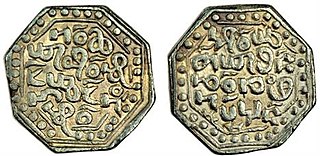
Sunyatphaa also Udayaditya Singha was the king of Ahom Kingdom from 1670 CE to 1672 CE. After his elder brother Swargadeo Chakradhwaj Singha died in the middle of Ahom-Mughal war, Udayaditya Singha succeeded to the throne. His reign witnessed the end of Ahom-Mughal war, which started during the reign of Chakradhwaj Singha, when the Mughal army led by Rajput prince, Ram Singh I of Amber, was decisively defeated by the Ahom forces led by Ahom commander Lachit Borphukan in the Battle of Saraighat. The later part of his reign was characterized by the failure of military expedition against the Dafala tribes and the influence of Paramananda Sannyasi, a saintly figure from Brindaban, over Udayaditya Singha. Udayaditya's over exerted devotion towards Paramananda Sanyasi, aroused dissatisfaction among the nobles, which ultimately caused his deposition and execution. His reign was followed by a series of political anarchy and internal disturbances in the Ahom kingdom which continued till the accession of Gadadhar Singha in 1681 CE.

Suhung also known as Samaguria Rojaa Khamjang was a king of the medieval Indian Ahom kingdom who ruled for a very short period. While most of the chronicles put the number of days of his reign as 20, in some chronicles the duration of his reign was shown as one month and fifteen days. Suhung was installed as king of Ahom kingdom by Debera Borbarua after the latter poisoned Ahom king Ramdhwaj Singha. His reign was characterized by the atrocities committed by his minister Debera Borbarua. Finally, Suhung decided to get rid of Debera Borbarua and put an end to his reign of tyranny, but the powerful minister outsmarted the king, by secretly poisoning his medicine and killing him.

Mo or Moism is the religion of most Zhuang people, the largest ethnic minority of China. It has a large presence in Guangxi. While it has a supreme god, the creator Bu Luotuo (布洛陀), numerous other deities are venerated as well. It has a three-element-theory. Mo is animistic, teaching that spirits are present in everything.

The Ahom religion is the ethnic religion of the Ahom people. The Ahom people came into Assam in 1228, led by a Tai prince Sukaphaa, and admixed with the local people. The people who came into Assam included two clans of priests, joined later by a third, who brought with them their own religion, rituals, practices and scriptures. The religion is based on ritual-oriented ancestor worship that required animal sacrifice (Ban-Phi), though there was at least one Buddhism influenced ritual in which sacrifice was forbidden (Phuralung). Ancestor worship and the animistic concept of khwan are two elements it shares with other Tai folk religions. There is no idolatry except for the titular god of the Ahom king and though there is a concept of heaven or a heavenly kingdom, there is no concept of hell. It was the state religion of the Ahom kingdom in the initial period.

Ahomisation was an assimilation process in the former Ahom kingdom of Assam by which the people from different ethnic groups in the region became a part of what is now considered as the Ahom population.

















